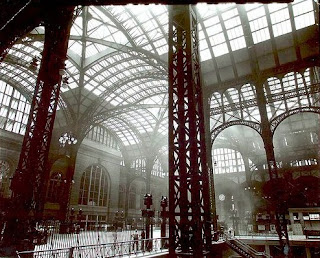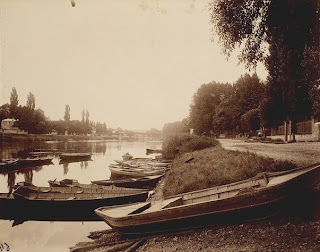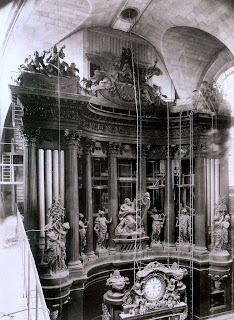Eugène Atget
(1857-1927)

Image courtesy of: http://misojosven.blogspot.com/
"This enormous artistic and documentary collection is now finished."
Born in the French city of Bordeaux in 1857, Eugène Atget was raised by his uncle after he was orphaned at the age of seven. In the 1870s, Atget worked as a cabin-boy and sailor on transatlantic ocean liners; after his shipping trade, Atget took up acting, performing as a player in a second-rate company but without any notable success.
In the 1890s, Atget settled in Paris where he established himself as a painter-photographer at the age of 42. In spite his limited training or experience in the visual arts, Atget saw photography as another source of income and he purchased his first camera by the mid-1890s. Selling his photographic work to artists from the nearby Montparnasse district - it was common practice for painters at that time to paint scenes directly from photographs - Atget advertised his photographs as 'documents for artists.'
With his camera, Atget recorded more than 10,000 images of the people and sights in and around Paris and its environs, including Versailles and Saint-Cloud. Atget retained a bohemian existence all his life, with an inclination for hard work rather than for recognition or fame - in 1899 he moved to Montparnasse where he worked and earned a modest income until his death in 1927 - he maintained a special interest in the working classes and tradespeople of Paris all his life. He was said to be short-tempered and eccentric - in his 50s, for example, he ceased eating anything other than bread, milk and sugar. Atget and his wife, Valentine - herself a former stage performer - retained their connections with the Parisian stage by socialising with some of the leading dramatists of the theatre world. (Source: newworldencyclopedia.org, 2008)
Hôtel de Marquis de Chantosme, 6 rue Tournon ~ 1900
Image courtesy of: http://polkaostrich.wordpress.com/
Atget's working methods included the use of a large-format wooden bellows camera and a tripod with a rapid rectilinear lens that he carried around on his shoulders. His nostalgically romantic, reflective images were exposed and developed as 18x24cm dry glass plates which were used by fellow artists, architects, decorators and publishers alike; he was also commissioned by the Carnavalet Museum and city officials to record and preserve for posterity Parisian landmarks, many of which have long since disappeared. Atget used long exposures with extended exposure times, preferring a fairly wide view to give a sense of atmosphere and ambiance while limiting his camera's range in order to avoid the bustling scenes of the metropolis around him, never far from his camera's eye. He would also photograph the same street corners or scenes from slightly different angles or positions at different times of the day. Favouring to record the the city's sceneries in their everyday realities, he once quipped about his career, "I have done little justice to the Great City of Paris." (Sources and citation from: newworldencyclopedia.org, 2008; artfact.com, undated)
Gate to the Château, Vaux de Cernay
Image courtesy of: http://www.dienes-and-dienes.com/
Atget's sublime and ghostly images of Paris were usually captured in the quiet light of the early or pre-dawn hours, when the city was still adequately free of traffic and people and he could work undisturbed. He managed to capture, forever, that bygone Paris of another era, an age of refinement and culture, rich with the architectural details of its cobbled streets, hotels, shops, quays, gardens, churches and courtyards. Atget deliberately excluded any mention of the relentless modernity and progressive industry fast encroaching on his Paris - the Eiffel Tower, with its complicated iron latticework, is conspicuous by its absence from his work. Instead, he focused his camera's lens on a more genteel Paris, the one which lay beneath all the novelty of iron and steel.
Aside from his talents being recognized by a few fellow artists such as Many Ray, Pablo Picasso, André Derain and Henri Matisse, Atget's work was largely ignored by the public. Except for a few curators who had been familiar enough with his work to have bought some of his photographic albums, Atget's death in 1927 went, for the most part, unnoticed outside his circle of friends. (Source: newworldencyclopedia.org, 2008)
Versailles ~ 1904
Versailles ~ 1922-23
The two images above are courtesy of: http://www.artnet.com/
It was only when Berenice Abbott (1898-1991), who had worked as Man Ray's assistant and knew Atget in the 1920s, had arranged for the Museum of Modern Art in New York to acquire a vast number of his prints from her collection in 1968 that French and American audiences finally became aware of Eugène Atget's work. It was thanks mainly to the efforts of Berenice Abbott, who was insturmental in publishing his prints, that Atget posthumously came to international prominence. Of Eugène Atget, Abbott wrote, "He was an urban historian, a Balzac of the camera, from whose work we can weave a large tapestry of French civilization."
During his lifetime and afterwards, much of Atget's work was merely regarded by scholars and art critics as being little better than documentary photography (for his part, Atget considered himself a chronicler of Paris, not an artist). Today his body of work is seen as much more than that: it is now generally regarded as a forerunner to the Surrealism art movement of the 1920s and Atget as one of the most influential and important photographers of the 20th century.
(Sources and citation: newworldencyclopedia.org, 2008; artfact.com, undated)
Saint-Cloud ~ 1904
The above two images are courtesy of: http://picasaweb.google.com/
Hôtel de Montmorency, 5 rue de Montmorency ~ 1908-09
Image courtesy of: http://www.geh.org/
Rampe de L'escalier de L'Hôtel Sully-Charost, 11 rue du Cherche-Midi ~ 1904-05
Image courtesy of: http://www.ago.net/
Image courtesy of: http://fromztoa.net/
Hôtel de Choisy, 8 rue de Barbette ~ 1901
Door knocker, Hôtel de Chateaubriand, 120 rue du Bac ~ 1902-03
Balcony railing, 15 rue de Petit Pont ~ 1913
Ornamental ironwork, Collégiale Notre Dame ~ 1921
The four images are courtesy of: http://fansinaflashbulb.wordpress.com/
Jardin du Luxembourg ~ 1906
Hôtel des Abbés de Royaumont, 4 rue de Jour ~ 1907
Intersection de la rue Lhomond et rue Rataud ~ 1913
The above three images are courtesy of: https://www.marylhurst.edu/
Carrousel
Cathédrale Notre-Dame de Paris ~ 1925
Quai d'Anjou, Île Saint Louis
Parc de Sceaux ~ 1925
Versailles
The five images above are courtesy of: http://missparlour.blogspot.com/
Grand Trianon, Pavillon de Musique ~ 1923-24
Vase, Versailles ~ 1905
Palais Royale
91, rue de Turenne ~ 1911
Un Coin du Quai de la Tournelle, 5th Arrondissement ~ 1910-11
Fontaine du Passage, 6 rue des Guillemites ~ 1911
Charenton, vieux moulin ~ 1915
Trianon, Pavillon Français ~ 1923-24
Coin de la Rue Valette et Pantheon ~ 1925
The above eight images above are courtesy of: http://www.masters-of-photography.com/
Rue du Figuier ~ 1924
Image courtesy of: http://susannalynn.blogspot.com/
Impasse de la Baudorie, rue de Venise ~ 1890
Hôtel, 19 rue de Varenne ~ 1900
Saint-Cloud ~ 1906
Notre-Dame, Porte Rouge ~ 1920
The above five images are courtesy of: http://www.artnet.com/
Rue de L'Hôtel de Ville ~ 1921
Image courtesy of: http://www.sauer-thompson.com/
Avenue des Gobelins
Image courtesy of: http://www.cristus-gallery.com/
Saint-Cloud ~ 1921-22
The above thirty-seven images are courtesy of: http://www.atgetphotography.com/
The above six images are courtesy of: http://art.findartinfo.com/
Hôtel du Grand Veneur, 60 rue de Turenne ~ 1901
The two images above are courtesy of: http://www.leninimports.com/

The above thirty-one images are courtesy of: http://misojosven.blogspot.com/
Image courtesy of: http://artblart.wordpress.com/
Versailles ~ 1923
Image courtesy of: https://artblart.wordpress.com/
Recommended reading:
Atget's Gardens: A Selection of Eugène Atget's Garden Photographs (1979), by Eugène Atget, William H. Adams, Royal Institute of British Architects & International Center of Photography: Gordon Fraser
Eugène Atget: Photographs of Old France (1984), by Rory Coonan, Museum of Modern Art, Serpentine Gallery & Arts Council of Great Britain: Arts Council of Great Britain
Eugène Atget: Paris (1998), by Eugène Atget & Wilfried Wiegand: te Neues
Atget (2000), by Eugène Atget, John Szarkowski & Museum of Modern Art: Museum of Modern Art
Atget, the pioneer (2000), by Eugène Atget, Jean-Claude Lemagny, Sylive Aubenas, Pierre Borhan, Luce Lebart, Hôtel de Sully & International Center of Photography: Prestel
Eugène Atget (2001), by Eugène Atget & Gerry Badger: Pahidon
Berenice Abbott, Eugène Atget (2002), by Berenice Abbott, Eugène Atget & Clark Worswick: Arena Editions
Atget: Pairs In Detail (2002), by Eugène Atget & Josiane Sartre: Flammarion
Eugène Atget: Unknown Paris (2003), by David Harris: New Press
Eugène Atget's Trees: Newly Discovered Photographs from the Bibliothèque Nationale de France (2003), by Eugène Atget, Sylvie Aubenas, Bibliothèque Nationale, Départment des Estampes et de la Photographie: D.A.P., Distributed Art Publishers
Looking At Atget (2005), by Eugène Atget, Peter Barberie, Beth A. Price, Ken Sutherland & Philadelphia Museum of Art: Philadelphia Museum of Art
Paris Changing: Revisiting Eugène Atget's Paris (2007), by Eugène Atget, Christopher Rauschenberg, Clark Worswick, Alison D. Nordstrom & Rosamond Bernier: Princeton Architectural Prress
























































































































No comments:
Post a Comment